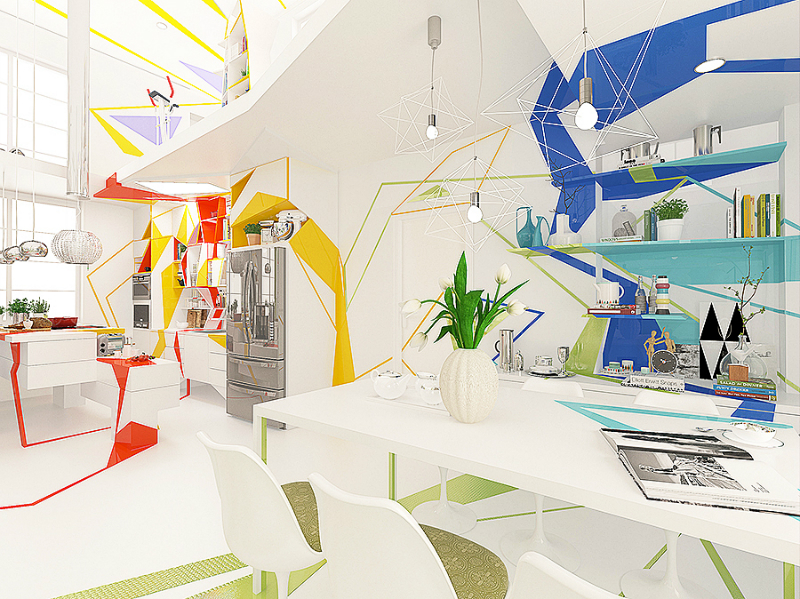Abstract Expressionism Ideas For Modern Interior And Original

Structural Expressionism, also called High-Tech Architecture, stands out with exposed trusses, beams, and columns giving rise to an industrial aesthetic. The building envelopes were light and partitions were reconfigurable. Hence, the structure became a part of the function of the building. This style expressed transparency in construction and.
"Life in Expressionism" by Brani & Desi Brani & Desi Archello

Pierre Soulages, a French artist from the early to mid 20 th century, echoed some of the elements of Abstract Expressionism as it developed in the US. Known for his Outrenoir (Beyond Black) paintings, Soulages, like Kline, used thick brushstrokes of black and white paint on his canvases. Though visually similar to Kline's, Soulages' work.
Life in Expressionism Decoholic

Einstein Tower in Potsdam near Berlin, 1919-22 (Erich Mendelsohn) Goetheanum in Dornach near Basel Switzerland, 1924-28 (Rudolf Steiner) Dutch expressionism (Amsterdam School), Het Schip apartment building in Amsterdam, 1917-20 (Michel de Klerk). Expressionist architecture was an architectural movement in Europe during the first decades of the 20th century in parallel with the.
Abstract Expressionism Ideas For Modern Interior And Original

With its propagation of exactly such goals, Expressionism offered a feasible way to cope with the problems of the early 1920s in Europe. Expressionism rejected the machine age as the foundation of artistic creation. In architecture, this came out as the opposition to design as conditioned only by utility, materials, construction, and economics.
Abstract Expressionism Ideas For Modern Interior And Original

Sold $40,000. Abstract Expressionism describes a style of abstract art developed by a group of primarily New York-based painters in the 1940s and 50s, also known as the New York School. This loosely affiliated band of artists, representing a diversity of practices, were united by a dedication to bold formal invention and a conviction in art as.
Expressionistische Raumgestaltung mit Farben und Formen

Expressionism was an early 20th-century movement in art and architecture that developed in Europe following World War I. It developed between 1910 and 1924 among a group of architects from.
Life in Expressionism by Brani & Desi Design, Interior design firms

A spiritual experience of moving around a giant sculpture is achieved in its interior and the color of the space in the interiors mirrors the shades of the sun and earth. 3. Einstein Tower , Potsdam by Erich Mendelsohn | Expressionist Architecture. The tower's design was derived from the structure and the expression of the purpose of the.
Brani Desi Project "Life in Expressionism" Interior design

With its bold and emotive brushstrokes, Expressionist art aimed to capture the inner complexities of human emotions. In today's modern world, we witness how various art movements influence.
Life in Expressionism by Brani & Desi Interior Design Studio, Interior

History of Expressionism in Interior Design Expressionism in interior design is a relatively new phenomenon. The style emerged at the turn of the 19th and 20th centuries (during the so-called era of modernism) when expressionists - artists, writers, and musicians - took the stage and revolutionized it.
A contemporary home inspired by 'expressionism', Bulgaria Adelto

December 27, 2014. Despite being born in the same era, Expressionism embodies an entirely different architectural sensibility to other proto-modernist movements like the Bauhaus. Its complex forms.
FIRST IMPRESSION OF EXPRESSIONISM IN INTERIOR STYLE

The second and principal wave of Expressionism began about 1905, when a group of German artists led by Ernst Ludwig Kirchner formed a loose association called Die Brücke ("The Bridge"). The group included Erich Heckel, Karl Schmidt-Rottluff, and Fritz Bleyl.These painters were in revolt against what they saw as the superficial naturalism of academic Impressionism.
Abstract Expressionism Ideas For Modern Interior And Original

The basic characteristics of the interior design style Expressionism. 1. Various colors and shapes. Particularly favored by expressionism interior design are cubic shapes and lines with sharp edges and striking color combinations that evoke powerful emotions in the observer. Sharp angles are handled skillfully, harmoniously, and not in a boring.
Life in Expressionism by Brani & Desi HomeDSGN Contemporary

German Expressionist Interiors. German expressionist architecture is a style of architecture which started in the early 20th century and became a prominent early modernist style in the 1920's and 1930's. The style was closely linked with other expressionist artistic movements, including those in film, dance, theater, and visual arts, and was.
Life in Expressionism by Brani & Desi HomeDSGN Interior design

Style in interior design Expressionism Interior and exterior design Expressionism (o T lat. Expressio, "expression" ) is an avant-garde trend in European art, developed in the late XIX - early XX century, characterized by a tendency to express the emotional characteristics of the image (s) (usually a person or a group of people) or the.
Abstract Expressionism Ideas For Modern Interior And Original

Late 19th - early 20th century. Expressionism, translated from Latin means "expression". Those. this means that applying this style in the interior, everyone acts as a creator, artist, in order to express their feelings, to convey them in the design of the room. This trend in art is most clearly reflected in the culture of Germany and Austria.
Life in Expressionism Decoholic

Contemporary Architecture. The expressionist movement had its heyday in Germany and the Netherlands in the 1920s. It brought dramatic new forms—curving walls and faceted domes, for example—to modern architecture, giving architects and clients new ideas about how concrete, in particular, might be used. Its ideas lived on to influence some of.